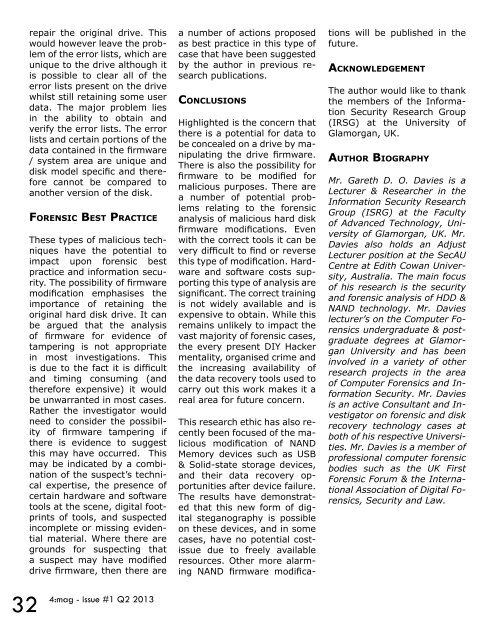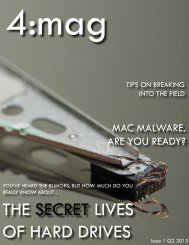You also want an ePaper? Increase the reach of your titles
YUMPU automatically turns print PDFs into web optimized ePapers that Google loves.
32<br />
repair the original drive. This<br />
would however leave the problem<br />
of the error lists, which are<br />
unique to the drive although it<br />
is possible to clear all of the<br />
error lists present on the drive<br />
whilst still retaining some user<br />
data. The major problem lies<br />
in the ability to obtain and<br />
verify the error lists. The error<br />
lists and certain portions of the<br />
data contained in the firmware<br />
/ system area are unique and<br />
disk model specific and therefore<br />
cannot be compared to<br />
another version of the disk.<br />
Forensic Best prActice<br />
These types of malicious techniques<br />
have the potential to<br />
impact upon forensic best<br />
practice and information security.<br />
The possibility of firmware<br />
modification emphasises the<br />
importance of retaining the<br />
original hard disk drive. It can<br />
be argued that the analysis<br />
of firmware for evidence of<br />
tampering is not appropriate<br />
in most investigations. This<br />
is due to the fact it is difficult<br />
and timing consuming (and<br />
therefore expensive) it would<br />
be unwarranted in most cases.<br />
Rather the investigator would<br />
need to consider the possibility<br />
of firmware tampering if<br />
there is evidence to suggest<br />
this may have occurred. This<br />
may be indicated by a combination<br />
of the suspect’s technical<br />
expertise, the presence of<br />
certain hardware and software<br />
tools at the scene, digital footprints<br />
of tools, and suspected<br />
incomplete or missing evidential<br />
material. Where there are<br />
grounds for suspecting that<br />
a suspect may have modified<br />
drive firmware, then there are<br />
4:<strong>mag</strong> - issue <strong>#1</strong> <strong>Q2</strong> <strong>2013</strong><br />
a number of actions proposed<br />
as best practice in this type of<br />
case that have been suggested<br />
by the author in previous research<br />
publications.<br />
conclusions<br />
Highlighted is the concern that<br />
there is a potential for data to<br />
be concealed on a drive by manipulating<br />
the drive firmware.<br />
There is also the possibility for<br />
firmware to be modified for<br />
malicious purposes. There are<br />
a number of potential problems<br />
relating to the forensic<br />
analysis of malicious hard disk<br />
firmware modifications. Even<br />
with the correct tools it can be<br />
very difficult to find or reverse<br />
this type of modification. Hardware<br />
and software costs supporting<br />
this type of analysis are<br />
significant. The correct training<br />
is not widely available and is<br />
expensive to obtain. While this<br />
remains unlikely to impact the<br />
vast majority of forensic cases,<br />
the every present DIY Hacker<br />
mentality, organised crime and<br />
the increasing availability of<br />
the data recovery tools used to<br />
carry out this work makes it a<br />
real area for future concern.<br />
This research ethic has also recently<br />
been focused of the malicious<br />
modification of NAND<br />
Memory devices such as USB<br />
& Solid-state storage devices,<br />
and their data recovery opportunities<br />
after device failure.<br />
The results have demonstrated<br />
that this new form of digital<br />
steganography is possible<br />
on these devices, and in some<br />
cases, have no potential costissue<br />
due to freely available<br />
resources. Other more alarming<br />
NAND firmware modifica-<br />
tions will be published in the<br />
future.<br />
AcknowledgeMent<br />
The author would like to thank<br />
the members of the Information<br />
Security Research Group<br />
(IRSG) at the University of<br />
Glamorgan, UK.<br />
Author BiogrAphy<br />
Mr. Gareth D. O. Davies is a<br />
Lecturer & Researcher in the<br />
Information Security Research<br />
Group (ISRG) at the Faculty<br />
of Advanced Technology, University<br />
of Glamorgan, UK. Mr.<br />
Davies also holds an Adjust<br />
Lecturer position at the SecAU<br />
Centre at Edith Cowan University,<br />
Australia. The main focus<br />
of his research is the security<br />
and forensic analysis of HDD &<br />
NAND technology. Mr. Davies<br />
lecturer’s on the Computer Forensics<br />
undergraduate & postgraduate<br />
degrees at Glamorgan<br />
University and has been<br />
involved in a variety of other<br />
research projects in the area<br />
of Computer Forensics and Information<br />
Security. Mr. Davies<br />
is an active Consultant and Investigator<br />
on forensic and disk<br />
recovery technology cases at<br />
both of his respective Universities.<br />
Mr. Davies is a member of<br />
professional computer forensic<br />
bodies such as the UK First<br />
Forensic Forum & the International<br />
Association of Digital Forensics,<br />
Security and Law.




